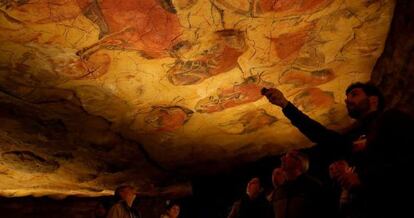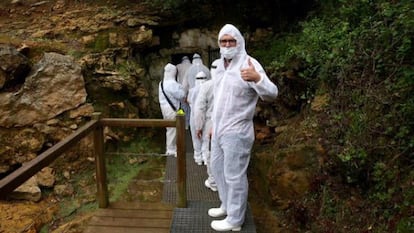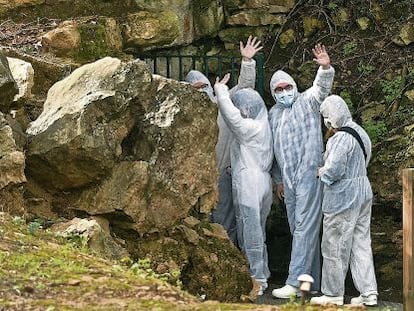A 37-minute prehistoric journey
As visits resume, EL PAÍS joins the first group to be allowed in to view Altamira’s cave art


This is the first time Leonore Weber, a 73-year-old retired psychotherapist from New York, has visited Spain. When she arrived at the Altamira caves on Friday morning as part of a guided tour of prehistoric sites in northern Spain organized by the American Museum of Natural History in New York, she had no idea her name had been included in a weekly lottery to choose five people to be allowed into the cave. Accompanying Weber were another American, a Norwegian, and two Spaniards.
“Their domination of art is incredible, their ability to use the space of the cave itself,” she said after her 37-minute visit, only eight of which are in the painted cavern. “It is astonishing to be able to see up close the birth of artistic sensibility and that this happened so early in our history,” she added.
Opening the cave is a political decision, and probably a short-term one” Prehistoric art expert Juan Vicent
The decision to continue allowing small groups of people into one of the most important Paleolithic sites in the world once a week has been criticized by some scientists, who say that it is endangering the paintings’ fragile ecosystem.
Everybody who has visited the cave, or others nearby such as El Castillo and Las Monedas, is affected in the same way: a mixture of mystery and emotion triggered by entering, through art, a past we can only imagine, populated by mammoths, rhinoceroses, giant reindeer and bison, along with predators such as bears and lions, all competing with humans seeking refuge from the ice that covered northern Europe at the time. There are fewer paintings in Las Monedas, but they are no less incredible than those in Altamira: a panel shows a stand-off between a horse and a reindeer, painted with charcoal. The lines are perfect, fluid, and confidently rendered, reflecting a deep knowledge of the world in which our ancestors lived some 15,000 years ago.
Some of the earliest examples of human art date back 100,000 years, such as the decorated ostrich egg shells found in Africa, but the attempts to represent reality are more recent, from around 40,000 years ago, and have been found in Europe, Indonesia, and Australia. “What set that in motion?” asks José Antonio Lasheras, the director of the Altamira Museum as he waits for next week’s lottery winners to be drawn. “We’ll never know. It has to do with who we are and what we feel, how we see ourselves reflected in images,” he says.
The Lion Man of Hohlenstein, carved on a mammoth tusk, is 34,000 years old, while the paintings in the Chauvet caves in France, discovered in 1994, date back 36,000 years. While the bisons of Altamira date back 15,000 years, other paintings there are up to 36,000 years old. In El Castillo, one pictogram is dated at 41,500 years, surely the oldest in the world.
That date is crucial, because it was just then that the most important event in human history was occurring: the arrival of the Cro-Magnons to Europe, which would lead to the eventual disappearance of the Neanderthals, who had dominated Europe for hundreds of thousands of years.
The birthplace of art covers just a few kilometers, occupying a series of caverns in the mountains of the Cantabrian cornice that now make up the Cave of Altamira and Paleolithic Cave Art of Northern Spain UNESCO World Heritage Site. In El Castillo, there are archeological remains dating back almost 150,000 years. “This cave has allowed us to order the chronology of European history,” says Lasheras.
The visits to Altamira, which have resumed following a year-long experiment after the caves were closed for 12 years, are carried out under strict conditions: no more than five visitors, each chosen by lottery, plus two guides, once a week. The decision has been criticized by the CSIC Spanish National Research Council. Juan Vicent, an expert on prehistoric art is among those opposed to allowing the public in to Altamira under any conditions: “All Paleolithic art faces the same conservation problems. Using it to feed the tourism industry leads to its destruction. This is what the specialists say. That is why the decision has been taken to create replica caves, allowing us to preserve the most outstanding examples of art of this kind, such as Altamira and Chauvet. Opening the cave is a political decision, and probably a short-term one.”
Visitors enter a past we can only imagine, populated by mammoths, rhinoceroses, giant reindeer and bison
A CSIC report highlights the danger to the caves posed by allowing visitors in. But a second report commissioned by the foundation that oversees Altamira established that damage to the paintings came from nature itself, and not from humans, as long as visits were kept to a minimum. Parts of El Castillo and Las Monedas are also closed off to visitors, for example an area containing a drawing of a mammoth calf – 90 percent of paintings in Europe are of the same animals: bison, wild bulls, deer, and reindeer.
But the lucky winners allowed into the caves on Friday, wearing their special suits to prevent bacteria being transmitted, remain unaware of the controversy. Norwegian Sverre Bauck, aged 66, an aficionado of cave painting who has visited other sites in Europe, says the experience was almost religious, “like being in another world,” adding that he is amazed at the precision and skill of the drawings: “They are comparable with Picasso.”
A stroll round Altamira

There are two things that most strike you about a visit to Altamira: the silence as we five lucky visitors stand in the darkness, and the explosion of red as the lamps are turned dimly on and we come face to face with the bison that decorate the ceiling above our heads. Not a sound is heard for the eight minutes we are permitted to contemplate one of the jewels of world prehistoric art. A distant murmur of falling water can be heard, and some of the perfectly executed paintings stand out in the dampness. All the mystery and power of Paleolithic art is concentrated into these few moments that represent a trip down a time tunnel to this remote corner in which our ancestors chose to celebrate the world they lived in more than 15,000 years ago.
We are allowed exactly 37 minutes in the cave system, and we are all too aware of the fragility of the environment we have entered. All around us are monitors and machines to measure the conditions down here, and we have been kitted out with protective suits and shoes before entering and the door being closed behind us.
The time passes quickly, and our expectation grows as we approach the main chamber. “Look father, there are oxen,” is what the daughter of Marcelino Sanz de Sautola, who discovered the cave in 1879, is reported to have said when she looked up at the ceiling. “They’re not oxen, they’re bison,” he replied. The exclamation seems to echo once more when you come face to face with the creatures today. The perfection with which they are drawn is astonishing, and not just those painted red, but also the charcoal outlines of others.
It is also extraordinary to see, from less than half a meter away, how the artists used the contours of the rock to highlight the anatomy of creatures they had obviously spent a lot of time studying. At the end of the cave, we find a deer, almost life size, one of the most extraordinary drawings to have been passed down from prehistory. The clock is ticking, time is running out, but the red and the silence will remain forever as a reminder of how imagery is part of our humanity, and always has been.
Tu suscripción se está usando en otro dispositivo
¿Quieres añadir otro usuario a tu suscripción?
Si continúas leyendo en este dispositivo, no se podrá leer en el otro.
FlechaTu suscripción se está usando en otro dispositivo y solo puedes acceder a EL PAÍS desde un dispositivo a la vez.
Si quieres compartir tu cuenta, cambia tu suscripción a la modalidad Premium, así podrás añadir otro usuario. Cada uno accederá con su propia cuenta de email, lo que os permitirá personalizar vuestra experiencia en EL PAÍS.
¿Tienes una suscripción de empresa? Accede aquí para contratar más cuentas.
En el caso de no saber quién está usando tu cuenta, te recomendamos cambiar tu contraseña aquí.
Si decides continuar compartiendo tu cuenta, este mensaje se mostrará en tu dispositivo y en el de la otra persona que está usando tu cuenta de forma indefinida, afectando a tu experiencia de lectura. Puedes consultar aquí los términos y condiciones de la suscripción digital.









































